LESSON 20: How to Please Your Audience
This lesson marks the completion of another ten-lesson period in your progress. You have forged ahead now to your second program lesson. This is, indeed, an accomplishment.
I know from your letters the inspiration and enthusiasm you have felt over your course in Magic, and I know how your interest and desire to learn has grown with each lesson. With such spirit you cannot help but succeed.
I know you yourself have noticed the improvement and development you have made in your mastery of the Great Mystic Art. I know the thrill you feel when you realize that you are learning the great secrets of an Art which no one else, perhaps, in your vicinity knows and that you are becoming skilled in Great Magic.
I need not say again that your investment of time and money in this course will bring returns a hundredfold.
Your friends, no doubt, have been astonished by your exhibition of Magical Power. If you have not felt capable heretofore of giving a performance before an audience, by the time you have reviewed your lessons up to this point and have mastered this lesson, you should feel well able to perform.
Go to the entertainment committees of your club, your lodge, your church, go to the schools in your neighborhood and offer your services. In most cases they will be delighted to have an entertainer whom they can call on. If you feel justified in doing so, charge something for your performance. If not, give your services gratis and you will gain immeasurably in experience and confidence and ability.
With this lesson I send you FREE several valuable pieces of paraphernalia, among which are a regular wand and a vanishing wand. I teach you an effect using the two wands so that you may have an entirely new kind of effect for a new program. I also teach you an interesting cloth band effect.
Before we proceed with the study of these effects and the arrangement of programs, I want to discuss further with you some of the factors in the Psychology of Magic, which you must know thoroughly to be a new type Scientific Magician.
1. HOW TO PLEASE YOUR AUDIENCE
The Dual Character of the Forces of Life
Everything in life has a dual character -- in every force in life lie the powers for both construction and destruction.
The fire that warms your home can destroy your home. The water that feeds your tissues can drown you. So you see, in the same thing lie the forces for both good and evil.
So it is with your Magic. All depends on whether you use it in a fine, skillful manner, or whether you abuse it and make light of it. Used properly, this great Art can mean tremendous success and happiness for you, but abused, it can mean your downfall.
Your audience, if pleased, will applaud you and heap praises on you and talk about you in a way that may "make" you. The same audience, if displeased with your appearance, your manner, your language, your performance, can hurt you. It is up to you, then, to please your audience. Study how to do this and you need never fear that you will not be successful.
What the Public Wants
People want illusion. They rush to the movies, to the theater, because they want to be entertained in an unreal world, a world of fancy. They want to live in their imaginations for a while and to forget life with its hardships. They find the theater a retreat where they can withdraw from everyday life and see things that are near the ideal.
Artists, writers, producers and actors work to produce the ideal. In the theatrical world all is illusion. There, people live through the troubles and experiences of the characters and find that in the end there is harmony. The lovers fall into each other's arms and live happily ever after. All difficulties are adjusted and everything has a pleasant outcome. The audience is pleased and happy that all is well. Each one has forgotten his own troubles and feels that his affairs will also have an agreeable ending.
This is a great factor in the explanation of the magician's power. He deals with the unreal. His art is so far removed from everyday life that the spell he casts over his public is tremendous. His is a world created entirely of fancy and not fact. He gives the people illusion. And that is what the public wants.
Another thing that the public is intensely interested in is mystery and the supernatural. These will never lose their fascination and, as they are the very stuff of which Magic is made, the Art of the Magician will never fail to hold people spellbound. Magic will never die, and the Magician with his power to produce supposedly supernatural effects will ever continue to thrill the public.
KEEPING UP WITH THE TIMES Change in the Character of Magic
The character of Magic, like that of everything else in life, has changed with the changing world. At one time a great deal of cumbersome apparatus was used — many trick cases and trunks and long table drapes. The Magician, too, was encumbered with voluminous robes.
Robert-Houdin, whom I have mentioned before as the founder of the modern school of legerdemain, did away with all the gaudy, clumsy paraphernalia of his predecessors. From his time sleight of hand came into its own and this, of course, does not require much paraphernalia. Many Magicians acquired great skill in manipulating small objects, such as coins and cards, and made a great success of it. T. Nelson Downs is a King of Coins in the magic world. Manuel is another clever coin expert. There was a craze at one time for coin acts in imitation of Downs. Special acts were also built around the use of cards. Howard Thurston was once famous for his card act.
This was the beginning of the development of impromptu and vest-pocket Magic, which of recent years has come into such popularity. The demand for Magicians to perform at clubs, in homes, at social functions, has required the further development of this type of Magic. In such cases the performer cannot have an elaborate preliminary set-up. This has necessitated the simplification of apparatus and the creation of effects which permit the use of paraphernalia which the Magician can carry about with him and for which he can use ordinary objects.
This simplification of paraphernalia and of effects has made the Art of Magic even more astonishing by reason of its impromptu and apparently makeshift nature.
This type of work has developed the suit case act, where the properties are carried in a suit case and are taken out and replaced as necessary. (See Lesson 10, How to Present a Program.) At such a performance the Magician is ready for work when he opens the suit case and has completed his act when he closes it.
The important thing in Modern Magic is not necessarily elaborateness, but novelty, surprise, something spontaneous and effective; and that is what the Modern Magician must give.
Individuality You Display Must be Suited to the Times
This brings us back again to a discussion of Individuality — an Individuality suited to the times. RobertHoudin was the first Magician to discard the old clumsy robes and to appear in a dress suit. He did the Art a good turn by making departure from the old order. Since his time, however, many performers have worn full dress, and not with such good effect. On the stage with a full evening show a la Thurston or Houdini, the dress suit is permissible, providing the performer is the type that can wear one. In view of the change in style, you are much safer in appearing in a Tuxedo for dress wear, thus avoiding any possibility of friction with the audience. For the informal performance the business suit will do very well. There is no need for you to try to display individuality in dress or appearance until you know just what you will accomplish thereby, and whether it is of positive benefit to you.
Take mustaches, for instance. At one time there was a craze for Magicians to wear mustaches and goatees.
It arose through imitation of a hero, the usual foundation for fads. This hero was Alexander Herrmann — Herrmann the Great. This great magician wore a mustache and a goatee. They enhanced his appearance and were well suited to him and gave him individuality. Those who imitated him, however, must have in many cases appeared ridiculous. Today we have Laurant, LeRoy, and Brush who wear distinctive looking mustaches and with effect. However, there are some would-be magicians who feel that they must have mustaches, regardless of suitability, to make them individual and great magicians. If these fellows don't grow them, they paste on big black mustaches and utterly disregard their complexions and color of their hair with the result that they present a ludicrous figure.
Set Your Stage in Keeping With the Times
Dealers in magical supplies have greatly influenced the stage settings of magicians, particularly of novices in the field. The dealers sell certain stock sets and apparatus. The result is that there has been too much sameness in stage settings. When the curtain rose or parted, there stood the old familiar magic tables, the same apparatus. This has grown very monotonous and uninteresting to the audience.
Other magicians went to the other extreme of too much display and gaudiness in striving for individuality. The pendulum is now swinging back again, however, to simplification of stage settings with better effect. It is not necessary to overdo special costumes and gorgeous scenery in these times. People like simplicity with artistic effect. You may make your stage setting colorful and unique, if you like, but keep it simple. Do not use old, cheap looking effects in your settings, and remember always to suit the occasion and the audience. Let good taste and modernism guide you.
MAKING AN IMPRESSION
How to Make Your Appearance.
The first impression which your audience forms of you is very important in your future success. You must, of course, be very careful of your magical properties. They must be kept in good condition so that they will be attractive and convey the impression that you have high standards in your work.
As to your personal appearance, I believe it is unnecessary for me to reiterate that you must be neat and careful about your clothes, your hands, your hair.
When you enter, walk in briskly. Do not shuffle along unless you are doing a comedy act and do it for effect. Walk directly to the center of the stage without looking at your audience. Do not bow and scrape and nod as you come in. Do not notice people until you are at the center of the stage. Then turn and face your audience and direct your attention to them. If you are to perform at a dinner or some other special occasion, do not get the attention of the guests until the time for your performance arrives. Only at this psychological moment must you make the audience notice you and keep their attention focused on you until you are through.
Always study your opening very carefully, for remember, you will sell yourself or harm yourself at the first moment of your performance.
Excercise Magnetism on Your Audience.
Keep your eyes! on your audience most of the time. Talk directly to them. Now and then for effect you may pick out one or more spectators and direct your attention to them. Talk convincingly to them and impress them, and you will find that this is a means of impressing everyone in that audience.
Talk distinctly and convincingly. Talk loud enough for every one to hear you and give enough force to your words to send them straight to the mark. Be careful of your language. Use judgment in what you say, and above all, speak correctly. Put expression into your voice and face -- avoid a monotone and a blank look. Put LIFE into your performance.
Create Interest in Your Spectators.
Your problem is to arouse and to hold the interest of your audience. Be snappy in your work and your audience will be interested in watching you. If you give a slow, long-drawn out program your spectators will fall asleep -- and that spells tragedy. You must not, of course, go to the opposite extreme and work so fast that your audience cannot follow you.
The next factor in creating and holding interest is attention to what the public demand is — what they want you to give them. The wise magician, just like the wise merchant, studies the trend of the times and the kind of things people are clamoring for. He then capitalizes on this. He presents to the people the things they want and are willing to pay for and presents them in attractive packages, that is, in a pleasing form.
Study your program from the standpoint of the particular occasion and the particular audience. Try in your effects and in your "Patter" to come within the experiences of your spectators. Do not do things and say things that are absolutely foreign to their own lives and that they will not understand. Enter into their own lives and their own knowledge a little and they will give you their understanding and appreciation. You will then have their interest and the success of your performance is assured.
MAINTAIN A HEALTHY ATTITUDE TOWARD MAGIC
You know from your own experience that it is always the unsuccessful fellow or the one who bears a grudge who is a knocker. So it is in Magic. The man who has made no mark in the profession or the man who is an out and out failure is the one who says that Magic is dead. That man sticks to the same old hackneyed program; he dresses the way magicians did years ago; his patter is stupid; and even his work is so poorly done that school boys ridicule him. His language is improper. He irritates his audiences instead of pleasing them. And then he goes about knocking Magic. His outlook is not healthy and he will never succeed until he wakes up and changes his attitude.
The man who knocks Magic has not had the proper foundation. He does not know the principles of Magic. He does not understand Magic as a Science. He does not know the proper way to present his effects. He does not know SHOWMANSHIP. He has not the slightest conception of the psychological nature of his work. How, then, can he succeed? He knows something is wrong and it does not occur to him to look within himself for the difficulty. No. Instead he knocks his profession.
You never hear the successful Magician knocking Magic. He finds it tremendously ALIVE and full of opportunity and big financial return. He is well known and admired. He is in demand. He will not discourage you for he has gained success and knows that you can. He is a BOOSTER. He, perhaps, has been discouraged himself many times by the knocker, but determination led him on until he reached the goal of the GREAT.
You must not let the knocker discourage you or plant any doubts in your mind if he should come your way. You know that you stand head and shoulders above him with your SCIENTIFIC TRAINING in MAGIC. You are enthusiastic and inspired, you are enjoying a rare opportunity in studying this course. Let nothing dampen your spirits. Keep your outlook healthy and you are bound to succeed.
We come now to the new effects in this lesson. They are easy to perform but permit of excellent
SHOWMANSHIP.
2. THE VANISHING WAND
A good effect with which to open a program.
EFFECT:
Performer, after tapping his wand on the table to prove that it is solid, wraps it in a piece of paper and gives it to a spectator to hold. Magician then suddenly grasps the wrapped wand and tears it to pieces. Mysteriously the wand has disappeared. Now, however, magician reaches into his inside coat pocket and produces the solid wand again and proceeds with it throughout his performance.
PARAPHERNALIA:
1--A regular wand — sent you FREE with this lesson.
2--A vanishing wand.
This is apparently solid like the regular wand, but in reality it is made of a paper shell with solid ends.
This is also sent you FREE with this lesson, including a few extra paper shells. 3--A piece of newspaper, about 17 inches square.
SECRET AND PATTER:
To Prepare:
Note how the special vanishing wand is made. It is a black paper shell with wooden plugs which fit into each end. Place this wand alongside of the regular wand and you will find them very similar in appearance. Figure 1.
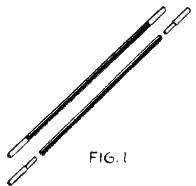
Because of the solid ends on the special wand, it can be tapped on the table and shown apparently to be solid. Even if it is dropped on the floor, it sounds as though it were solid and a regular wand.
Have wand and paper on table, or if you choose, you may enter with special wand in your hands.
Tuck the solid wand away beforehand in your inside coat pocket. Push the upper end back under pit of right arm so that there will be no danger of exposure. Better still, make a long narrow pocket for the wand to fit into. To do this, just sew a piece of black cloth of the proper size inside of your coat.
To Perform:
Have special wand in your hands.
"For years the Hindu Magician has been known for his baffling experiments in Magic. Tourists have come from all over the world to see the mysteries of this ingenious mystifier. No spectator has ever discovered any of his profound secrets. One experiment which the Hindu does is a particularly interesting one. He takes a small stick or twig from a tree. My wand will answer the purpose here for it is a piece of ebony wood tipped with ivory."
Tap wand on table two or three times to show that it is solid. Be sure to tap the wooden ends and not the paper shell for this may tear over the end of the table. Figure 2.

"He usually passes the stick around among the spectators, and then, picking up a piece of paper, wraps the wand carefully in it."
Take piece of paper and wrap wand in it. Start at one corner and roll the wand up diagonally across the paper. This keeps the wand within sight of the audience until it is completely wrapped. Figure 3.
"Then he twists the paper tightly at each end so there is no chance for escape."
Twist the paper about each end of the special wand. The paper now completely covers the wand. The audience knows that it is there, however, for they saw you actually wrap it up. Figure 4.
"Then he gives the wrapped stick to some spectator to hold. Will you sir. please hold this wand?"
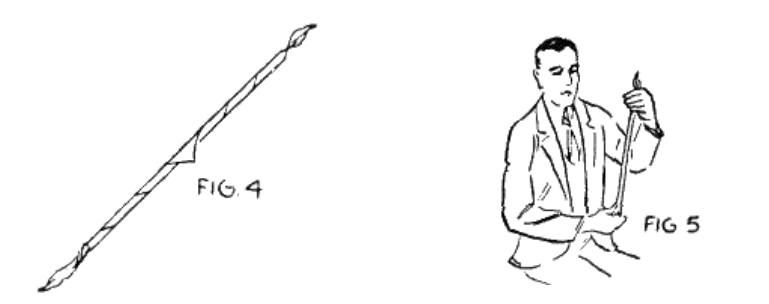
Give wrapped wand to spectator. Have him hold the wand vertically with his right hand at the bottom wooden end and his left hand at the top wooden end. Figure 5.
"You feel the stick, do you not? Wood is pretty solid, and if you are feeling well at all — which you seem to be -- it isn't difficult to detect. Perhaps you had better just stand up so that all of the audience can see." Have gentleman arise and hold wand in same position so that all can see.
"Suddenly the Hindu reaches over and grasps the paper."
Suit the action to the word. Reach over and take wrapped wand from gentleman.
"He says, 'Hi-Hi,' and tears it into pieces."
Tear paper through the middle. Then place the two halves together and tear them through again. Crumple up the paper into a ball and throw it aside or drop it on the table.
The tearing of the wand is not difficult. The wooden ends are small and are not noticed when the paper is crumpled up. Be careful that no one gets hold of the paper to examine it. Always destroy your evidence as soon as possible.
"The gentleman here wants to know what became of the stick. I shall explain it. Do you remember when I said, 'Hi - Hi'? That was the signal for the stick to jump."
Reach in and take regular wand from inside right coat pocket with left hand. Flourish the wand around and show it to audience. Figure 6.
"And here it is in my inside pocket."
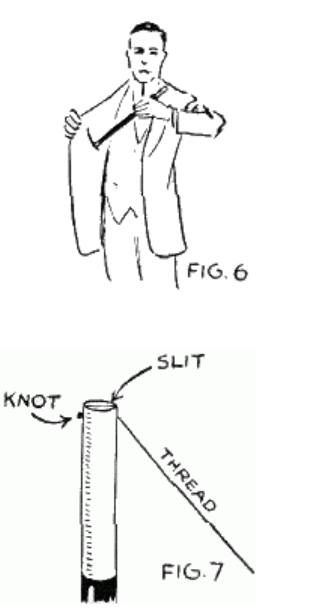
SUGGESTIONS:
The principle of the vanishing and reproduction of a wand permits of many variations.
For quick action the performer wraps wand in paper after showing it to be solid and tears it up immediately without giving it to an assistant to hold.
Another interesting way to produce a wand is to get an opaque flower vase and place it on the table. Make a little slit in one end of the wand into which insert the end of a piece of thread. Knot the free end of thread so that it will not pull out. Figure 7.
Drop wand, prepared end downward, into the vase. Vase should be high enough to cover wand when it is inside. Now run thread over to back of table and tie to a tack or staple, as you did in rising card experiments. Figure 8.
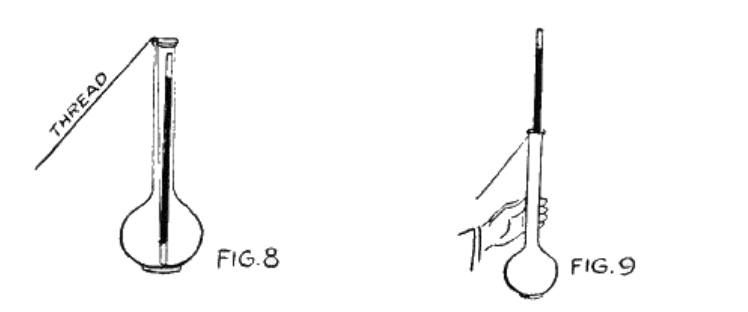
Pick up vase in left hand and bring it forward. The tightening of the thread will cause the wand to rise up out of the vase. Grasp wand with right hand before it topples over. It will pull away from thread easily. Figure 9.
If an assistant is available, run the free end of the thread out to him in the wings offstage. You need not touch the vase, then, but have him cause the wand to arise by pulling the thread.
3. KING SOLOMON'S MARRIAGE BANDS
This is a modification for practical use of the old Afghan Bands. It is an age-old principle brought up to date.
There is a touch of comedy in this effect and because of its nature, it is adapted to mixed audiences made up of a group of young people of the marriageable age.
EFFECT:
Performer shows a band of bright red cloth. He tears it in two, thus forming two separate rings. One of these rings is torn in two parts and instead of forming two rings, the two bands are found to be linked together. The other half of the original band is torn in half and the surprising result is one large band instead of two separate bands.
PARAPHERNALIA:
1 -- A strip of bright red percale --one yard long and four inches wide.
SECRET AND PATTER:
To Prepare:
Get a yard of percale and make up a few of these bands. Percale comes in yard width. One yard will make nine bands. The material tears crosswise very easily and you will find no difficulty in tearing it into four-inch bands.
Take one four-inch band. With a pair of sharp scissors cut a slit two and a half inches long in one end and one inch long in the other. Figure 1.
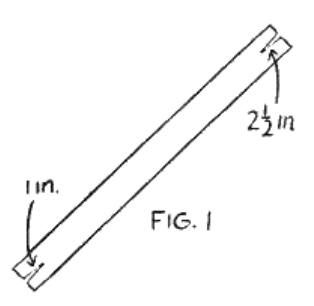
Bring the two ends of the band together. Take lower left-hand end of strip and give it a half twist. Sew it to upper left-hand strip with white thread. By doing this, you bring the inside of the cloth at one end against the outside of the cloth at the other end. Figure 2, next page.
Take the lower right-hand end and give it a whole twist. Sew this end to the upper right-hand end with black thread. This whole twist brings the outside of the cloth right back again to outside of the upper end. Figure 3.
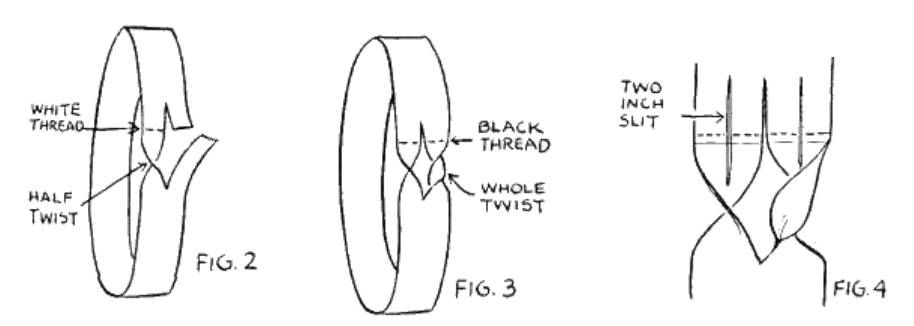
Through each of the two sewed sections of the band cut a slit about two and a half inches long. Figure 4. Fold up the band with faked ends inside. Have ready on table.
To Perform:
Pick up folded band from table and hold it in left hand.
"It is said that King Solomon was a very wise man -- so wise that he was able to keep peace among one thousand wives. Men in this day and age wonder how in the world he did it. I have discovered the secret — not from King Solomon himself for I never knew the gentleman personally — but in a roundabout way from a friend whose great great grandfather's great great grandfather's great great grandfather was personal magician to the King and thus he got the inside information. It seems that the King knew how to pick 'em. Before he married each time of the thousand times, he brought out his magic marriage band."

Unfold the band, taking care to keep the prepared side at the back and away from the audience. Hold band over left hand as in Figure 5.
Figure 6 shows front view. Band appears to be ordinary to the audience.
"This is one of them — a strip of red cloth made in the shape of a circle. He would tear the circle apart."
Grasp band through large slit in middle, one hand holding each side of the band. Pull sideways in opposite directions, tearing the band until it is torn through into two separate bands. Figure 7.
Hold one band in each hand with prepared joining covered by palms of hands. Figure 8.
"And when it tore into two separate rings, he knew that the young lady before him was not in harmony with him and that their lives were too far apart."
Let the ring that is sewed with white thread hang over your left arm and take the ring that is sewed with black thread in your right hand.
"Perhaps the band, however, when it was torn formed two bands, one linked in the other."
Insert fingers of both hands into slit in this band and pull apart until band is torn all the way around. The result will be one band linked in another, caused by the half twist which you made in joining the band. Figure 9.

"This was better — while they moved in separate circles. they were linked together in other respects."
Drop linked bands on table. Take other band from left arm and put fingers in slit in readiness for tearing.
"Then came the real test."
Tear band all the way around. The result will be one large band instead of the two that one would expect; caused by the whole twist which you made when joining this band. Figure 10.
"He tore the band again and it became one large band. He knew then that the young lady and he were in harmony and were joined together as one. So they were married and lived happily together ever after."
4. ARRANGEMENT OF PROGRAMS
The big idea in arrangement of programs is to get the interest of the audience, to hold their interest, and to make a lasting impression.
I have already discussed with you the importance of getting the interest of your audience. This puts the audience into a receptive mood and establishes a pleasant connection between performer and audience. Then the effects must progress to keep the audience keyed up until you reach your last effect — your masterpiece. Your finishing number must be so good that it wins an outburst of spontaneous applause from every member of your audience. As to what your masterpieces or finishing numbers will be, I cannot say. They depend on your personality and your likes. You can judge for yourself what effects are fitted to you and which you will make a big success with.
Have VARIETY in your programs. Inject plenty of comedy touches to break the tension of seriousness. You must get the contrast between seriousness and fun into your programs. Keep your audience in a wave of emotion -- now laughing, now tense, then laughing again. In this way, you avoid being monotonous and tiresome, by not overdoing the humorous or overemphasizing the serious. Then with your last effect, make an impression that will hold. Leave your audience talking about you.
These programs which I have arranged for you are for Club or Parlor work or any occasion which demands the smaller program. While they may be used also for Stage work, they are particularly adapted to the less formal presentation.
I.
1 -- The Vanishing Wand (Lesson 20)
2 -- Chinese Paper Tearing (Lesson 4)
3 -- Producing a Card from a Whole Orange (Lesson 14) 4 -- The Bewitched Banana (Lesson 14)
5 -- King Solomon's Wedding Band (Lesson 20) 6 -- Cards That Pass in the Night (Lesson 12)
* -- For an Encore — Cards Up the Sleeve (Lesson 13)
II.
1 -- The Vanishing Wand (Lesson 20)
2 -- Mystery of the Traveling Numbers (Lesson 8)
3 -- Snap It. (Lesson 17)
4 -- Mystery of the Glass House (Lesson 17) 5 -- Rising Card Escape (Lesson 9)
6 -- The Card and the Banana (Lesson 14)
7 -- Three Cards Through the Handkerchief (Lesson 16)
8 -- Japanese Thumb Tie (Lesson 11)
III.
1 -- King Solomon's Marriage Band (Lesson 20)
2 -- Vanishing Cigarette in Handkerchief (Lesson 2)
3 -- "Tack It" (Lesson 16)
4 -- Card Through the Handkerchief (Lesson 16)
5 -- Rising Cards in Glass, (Lessons 18 Or Any Other Rising Card Effect 19)
6 -- Mystery of the Glass House (Lesson 17) 7 -- Cards That Pass in the Night (Lesson 12)
I WANT TO HEAR FROM YOU
I am intensely interested in how you are progressing with your studies, and I am very eager to know whether you have begun to perform.
I have received enthusiastic letters from some of you, and I want to hear from others. Perhaps those who have not written are too busy with their studies and their Magic shows to spend time writing. If that's the case, it pleases me greatly. However, I should appreciate hearing of the success of my students and wish the busy ones would make a special effort now to write their teacher the good news.
Tarbell System Incorporated, Chicago.
LESSON 21
This lesson gives you your foundation for SLEIGHT OF HAND WITH COINS. This starts you on an entirely new group of principles in your study of the great art of Sleight of Hand and teaches you a great many important coin manipulations.
Bạn đang đọc truyện trên: truyentop.pro